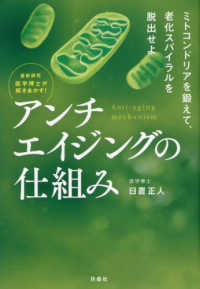Full Description
From the Chinese perspective, looking at translation studies' development of new, serious interests in social and cultural issues make translators or translator-trainers more sensitive to structural means available for textual management and, if necessary, more coherent in explaining why a specific textual choice is made in translation, among the many possibilities present in a sociocultural situation within a linguistic systemadopts an issue-driven, phenomenon-focused and theorization-oriented approach with strong implications for teaching and practice of translation. As such, it is not only explanatory, but also critical and constructive, and, in a well-grounded
Contents
Table of ContentsAcknowledgementsChapter One Introduction: Towards a positive study of translation3+1 childhood diseases'Theory''Theories' or 'turns'Relativity of validityBourdieu's language theory revisitedInsights from Friedman and Iser1.6.1 Friedman's (1953) characterization of positive economics outlined1.6.2 Iser's (2006) conceptual framework of critical theory outlinedPositive translation studiesBetween theory and practice: Theorization and applicationAbout this bookChapter TwoStructure of Meaning (SOM): Making of meaning and Triggering of discursive experience 2.1 Preamble2.2 Systemic Functional Linguistics (SFL): Translation as text re-creation2.3 Speech acts: Intentionality in translation2.4 Structure of Meaning: An integrated three-dimensional model of meaning making2.4.1 The compositional dimension 2.4.2 The interactional dimension 2.4.3 The experiential dimension 2.5 Relationships between the dimensions of SOM2.5.1 Dimensions of SOM: A generic view2.5.2 SOM: Form and substance2.6 Translation: A discursive experience in three dimensions2.7 SummaryChapter ThreeFrom structure to experience: Meaning making in translation 3.1 Preamble3.2 What we have understood about translation: A brief overview3.3 Sense, meaning, and meaning making3.4 Dynamics of meaning making: Ingarden's conception of 'moments'3.5 Reading and experiencing: A tryout3.6 Experiment with focus management in translation3.6.1 A linguistics text in translation3.6.2 The opening sentence of The Old Man and the Sea in Chinese translation3.6.3 A linguistics text in translation re-examined: Management of information focus3.7 Discussion and conclusionChapter FourThe Sentence as Unit of Translation (UT): From function to experience 4.1 Preamble4.2 Between text and sentence: UT redefined4.3 Case study one: Within and beyond a sentence4.4 Case study two: From sentence to text4.4.1 Textual integrity of sentences in the source text4.4.2 A translation experiment from the perspective of textual integrity4.5 Discussion and conclusionChapter FiveAugmentation of transitivity: Modification and attention management in translation5.1 Att- and adv-modification: A preliminary framework5.2 Modification: To indicate, to describe, or to define5.3 Comparability between att- and adv-modification in attention management5.4 Modification: Information distribution and attention management5.5. From external to internal modification: Looking into a word5.5.1 Meaning structured in a word5.5.2 Internal modifiers: Morphemic and sememic5.6. From morphemic to sememic modification: Looking into a morpheme5.6.1 Word meaning development and its implications for translation5.6.2 'Skewed' correspondence and its implications for translation5.7 False and pseudo morphemic modifiers5.7.1 False morphemic modifiers5.7.2 Pseudo morphemic modifiers5.8 Attention management and manipulation through modification: Three case examples5.8.1 Angry Birds, Twelve Angry Men, etc.5.8.2 The Wife5.8.3 'steel deatt qin'5.9 SummaryChapter SixTouching base with text: Repetition and signification in translation6.1 Preamble6.2 What kind of linguistics?6.3 Why (not) literary texts and literary translation?6.4 Leitmotif as VTU in literary translation: The mapping of a textual network6.5 Operation of leitmotif as VTU: Case examples6.5.1 From Chinese translations of John Galsworthy's The Apple Tree6.5.2 From Chinese translations of F. Scott Fitzgerald's The Great Gatsby6.6 Discussion: Textual network, effect, and apurposiveness of literary translating6.6.1 Accountability for the network of signification: Leitmotif as VTU6.6.2 The apurposiveness of artistic creation: From illocutionary to perlocutionary6.7 ConclusionChapter SevenLanguage in action: Syntactic iconicity and translation7.1 Of arbitrariness and iconicity: From language to text7.2 Syntactic iconicity: Form, function, effect7.3 Iconicity as 'foreignization' in creative writing: Wang Meng's 'The Eye of Night'7.3.1 Case One: Iconicity of short sentences7.3.2 Case Two: Iconicity in a long sentence7.4 Iconic in translation: To be, or not to be7.5 ConclusionChapter EightDeceptive language and conflict of experience: Text (re)production and dissemination through translation8.1 Situation, culture and text (re)production8.1.1 Relating skill to situation 8.1.2 Culture: Its behavioural dimension of tool making8.1.3 From tool making to sign making8.1.4 Text as sign8.1.5 Cultural awareness in text (re)production and dissemination 8.2 Text (re)production and dissemination: A case study8.2.1 The historical situation of the source text production8.2.2 A present-day situation of translation8.3 Critique and discussion8.3.1 The translation as a primary sign8.3.2 The translation as a secondary sign8.4 ConclusionIndex








